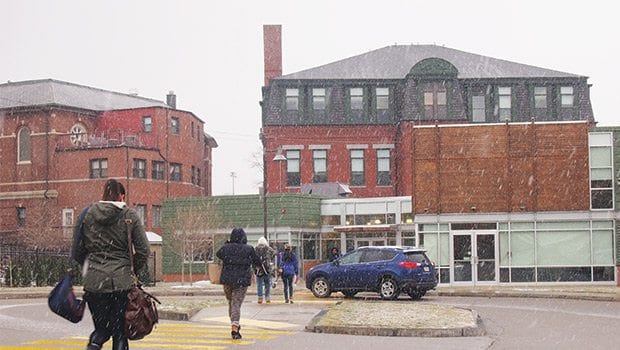Report details racially disparate suspension rates in Massachusetts
Lost instructional time is achievement barrier; charters, alternative schools top suspenders

A new report released from the UCLA’s Center for Civil Rights Remedies puts numbers to the racially-disparate application of out of school suspensions in Massachusetts. Among revelations: In the state, black students lost nearly three times as many days of instruction due to suspension for minor misbehaviors as their white counterparts.
Report co-author Dan Losen, as well as previous research by CCRR scholar Russel Rumberger, tie high suspension rates to lower graduation rates and academic outcomes, suggesting resolving disparate suspension rates could be a significant way to redress achievement gaps.
On the web
View the report: http://schottfoundation.org/report/suspended-education-massachusetts
“Missed instruction time can have a devastating impact on students’ academic achievement, and suspensions are known to be closely related to graduation rates and involvement with juvenile justice,” states the report. “Missing three or more days of school in the fourth grade in the month before assessments predicts a reduction in reading achievement by one full grade level on the National Assessment of Educational Progress.”
Lower academic achievement in turn can mean reduced wages later in life, at times creating a greater demand for public assistance and in some cases greater likelihood of involvement in crime, states the report. Such related expenses, as well as the lower taxes garnered from lower-wage workers, reduces the state’s potential revenue, presenting an economic argument for education discipline reform, the report states.
While the report acknowledges that many factors external to school can produce absenteeism, schools should take full control over the factors they do control, including not actively sending students away, the report states.
Racial and ableist disparities
In Massachusetts, blacks students and students with disabilities lost more days of instruction time than white students, and more days due to suspension for minor offenses.
During school year 2015 to 2016, on average there were 13 days of instruction time lost by white students per 100 white students. Black students and students with disabilities lost even more class time. For every 100 black pupils, there were 34 days of class time lost by black students. Similarly, students with disabilities lost 34 days for every 100 students.
The impact of discipline policy is evident, however. On average, for every 100 white students, 6 days were lost by white students due to suspensions for noncriminal, nonviolent, nondrug offenses. Meanwhile, for every 100 students with disabilities 19 days were lost for minor offenses, and for every 100 black students, 21 days were lost.
Concentrated suspensions
Statewide, schools varied widely in their discipline policies. While at nearly 69 percent of schools in Massachusetts had fewer than 10 days of instruction lost per 100 students during school year 2015-2016, at 0.6 percent of schools (11 schools) per every 100 students there were 200 to 515 days missed, according to the report.
At 1.5 percent of schools (27 schools), for every 100 students there were 100 to 199 days lost, and at 19.4 percent, or 360 schools, for every 100 students there were 17 to 99 days lost.
Top suspenders
The highest suspension rates were found at charter schools and alternative schools, Losen said.
Alternative schools are those designed to serve needs not met in traditional school environments, including behavior problems.
“Some people think, ‘Oh, well of course those schools would suspend more students,’” Losen said in a Banner phone interview. “But you have to realize that these are schools set up, at least in theory, to address the kids with behavioral issues. They should have the personnel and adequate staff to help those kids stay in school more and shouldn’t have, in some cases, incredibly high suspension rates. It’s not a good use of our tax dollars if their primary response for minor misbehaviors is to kick the kids out of school. We don’t want any kids unsupervised, on the streets, especially because of minor misbehaviors.”
Along with alternative schools five charter schools stood out for the highest suspension rates, including three in Boston: UP Academy Boston, City on a Hill in Dudley and City on a Hill at Circuit Street.
The Boston area school with the highest racial disparity in suspensions was Dorchester’s UP Academy Boston charter school — it also has the third largest disparity statewide. During the 2015 to 2016 school year, for black pupils, there were 194 missed days of instruction per 100 students; meanwhile, among white students, there were only 41 days of missed instruction per 100 students, representing a 154-day gap.
Also listed with notable racial suspension disparities were Boston’s Clarence R. Edwards Middle School, with a difference of 76 more days lost by black students per 100 black students than lost by white students per 100 white students; Lila G. Frederick Middle School (75 days more); Lyon Upper 9-12 (75 days more), Madison Park High (74 days more), and Brooke Charter School Mattapan (71 days more). Losen said additional high rates are at the Dever (71 days more) and UP Academy Holland (64 days more).
Only schools with populations of at least 100 students, including at least 10 white students and at least 10 black students, were considered for the racial gap analysis.
The report said that across the state, one strong driver of high suspension rates appeared to be principal perspectives on discipline. Schools with principals who responded on a statewide survey said that they regard strict discipline as a necessary punishment response and blame parents and children for problematic behavior had high suspension rates compared to those whose principals who regarded discipline not as retribution, but rather as a method for teaching student what is appropriate behavior.
Action
To ensure the report’s information is acted on, Losen calls for the state Department of Education to require schools to include on their accountability reports the number of days of instruction students missed due to discipline.






